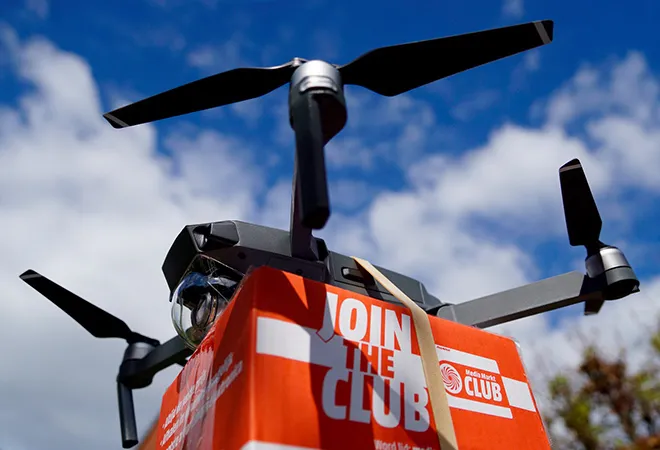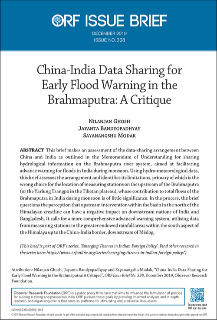
Emerging technologies like drones have played a critical role during COVID-19 as a mechanism for law enforcement, delivery or healthcare services and delivery for e-commerce platforms amongst other roles. As we transition to an increase in the demand from the traditional delivery mechanisms to a more preferable contactless delivery system of food, medicines and essentials, the regulatory frameworks governing drones needs to keep up with the acceleration in technology.
The Indian drone market has a potential of $900 million by the end of 2021 compared to the global market which rests at $21.47 billion. Even though these numbers are pre-Covid, the extensive use of drones in driving the COVID-19 response at the ground level could lead to an increase in the demand and growth in the industry. Studies indicate drones have the potential to bring down the cost of compliance and provide not just reliable data but an alternative vehicle for transportation and mobility.
Roadblocks to large-scale adoption of drones
There exists a growing space of commercial application of drones adopted by various other countries in sectors like Inspection and Maintenance, Cinematography, Precision Agriculture, Surveillance and Monitoring, and Gas and Refining that have not been fully explored in India. The exploration of drone applications in India has been hindered by existing barriers to large-scale commercial production and adoption. The dynamic ecosystem, coupled with the alien nature of the technology has presented policy makers a complex challenge to navigate. To this end, the sudden and an abrupt ban on the use of civil drones in India in 2014 slowed the efforts of the emerging drone industry by several years. The subsequent regulatory policy on drones, essential to guide the industry, was issued only four years hence. Under the released guidelines, flying a drone was certainly not as straightforward as procuring it — one cannot simply take a drone and pilot it into the airspace without adhering to a list of compliances. The Digital Sky platform, part of the policy, lays special emphasis on ‘No Permission – No Takeoff’ (NPNT) technology, which requires a system based permission mechanism requiring firmware and hardware additions without which a drone cannot take off.
The exploration of drone applications in India has been hindered by existing barriers to large-scale commercial production and adoption. The dynamic ecosystem, coupled with the alien nature of the technology has presented policy makers a complex challenge to navigate.
Currently, the online and offline markets are flooded with drones without NPNT provisions. There is also an absence of awareness of the Digital Sky platform amongst manufacturers and users alike. For a country like India, where drones are imported, NPNT will be a roadblock as drones will have to be modified as per the Indian regulations.
The Indian airspace has witnessed minimal use of commercial drones in various sectors. For instance, drones were used by an autonomous agency of the GOI in the 3D mapping for the Detailed Project Report (DPR) of the Raebareli–Allahabad Highway. DeTect Technologies along with Hindustan Petroleum, Indian Oil and GAIL has developed its proprietary positioning system that allows drones to monitor structures like a boiler inside a plant, autonomously. Drones were also deployed to monitor the 13 crore plantation in the city of Nagpur by the Indian Forest Department in the year 2018. Companies like Tata Steel are working towards deploying drones for monitoring. Urban Air Mobility (goods and delivery through drones) which is already being explored by Zomato among others in India. Globally, Alphabet as well as Amazon have succeeded in attempting delivery of packages through drones. Emerging countries in Africa are adopting technology at a much faster rate in partnership with international organisations like UNICEF to fight diseases like cholera, malaria, and healthcare delivery in the most remote areas. Further, Urban air mobility has already started to shape discussions among urban city planners, with involvement of private players such as Hyundai. However, the efficacy in the policies and regulations have hindered the growth of the industry.
Although India has seen a rise in the use of drones in commercial spaces by various states
during the pandemic, in the post-pandemic era, there is a need for this impact to be realised at the macro-level as a crucial part of policy response in the post-COVID-19 landscape.
Creating a demand based ecosystem
COVID-19 could be a catalyst for the large-scale adoption of drones in commercial spaces. The most significant rise in drone application can be in sectors like health, agriculture, city planning and administration, village mapping, emergency response and rescue, damage assessment, flood monitoring, inventory management, retail, and delivery of goods and food services.
Drones have been used to enforce lockdowns, some states have utilised them for disinfecting certain areas. If we look at the other countries, during the pandemic drones are widely used to deliver groceries and medicines in rural parts of Virginia. In parts of China, drones equipped with speakers were used to communicate information and the Zhangjiashan community also saw the use of drones for temperature checks. Zipline is playing a crucial role in the rural areas of Rwanda by deploying drones to deliver medicines, test kits as well as samples back and forth. Although the use of drones for such purposes in India has been limited, it has served as a launch pad for the industry and improved its credibility for future applications. For instance, the GOI has recently launched a programme to map all villages in the country using drones to create a digital repository.
The most significant rise in drone application can be in sectors like health, agriculture, city planning and administration, village mapping, emergency response and rescue, damage assessment, flood monitoring, inventory management, retail, and delivery of goods and food services.
While it is expected that government agencies will be one of the largest end-users of the industry, new ecosystems will have to be developed via public-private partnerships. As mentioned in the draft DGCA Circular on Requirements for Operation of Civil Remotely Piloted Aircraft System (RPAS), provisions and easy access for testing will have to be made for private players as well. State governments should have central drone exploratory initiatives to explore drone applications across the state. For example, every district collector can be equipped drones to be operated for various applications. Furthermore, this effort can be centralised to study and explore the various applications in depth.
Skilling and training is another critical area that will enable a smooth and safe transition and India expands its drone usage especially in the private sector. In this regard, the Indian Institute of Drones (IID) powered by the GOI can play a vital role in training young professionals in drone technology, UAV piloting and other operations with an emphasis on safety and security.
Indian government and private players should tap into this technology strategically not just in terms of decongesting cities and roads but also to set up manufacturing. To this end, under the Make in India initiative and self-reliance theme manufacturing clusters can be identified not just to meet the domestic demand but to cater to the global demand which is expected to grow on the back of increased adoption.
In conclusion, there is a need for the government to build a holistic policy around the industry by improving the existing policy framework concerning various stakeholders which caters to the ongoing COVID-19 pandemic and post. This will further create a demand for the necessary provisions for the required infrastructure. The government should also look at realigning the regulations of the drone industry with the central policies of ease of doing business and Aatmanirbhar Bharat to aid the domestic growth of the industry. As the sector currently driven by the adoption of applications around COVID-19 evolves and matures, societal concerns around data protection and privacy will also have to be taken into consideration.
The views expressed above belong to the author(s). ORF research and analyses now available on Telegram! Click here to access our curated content — blogs, longforms and interviews.




 PREV
PREV


